Copyright Michael Karbo and ELI Aps., Denmark, Europe.
30. Inside the CPU
Instructions have to be decoded, and not least, executed, in the CPU. I won’t go into details on this subject; it is much too complicated. But I will describe a few factors which relate to the execution of instructions. My description has been extremely simplified, but it is relevant to the understanding of the microprocessor. This chapter is probably the most complicated one in the guide – you have been warned! It’s about:
If we continue to focus on speeding up the processor’s work, this optimisation must also apply to the instructions – the quicker we can shove them through the processor, the more work it can get done.
Pipelines
As mentioned before, instructions are sent from the software and are broken down into micro-ops (smaller sub-operations) in the CPU. This decomposition and execution takes place in a pipeline.
The pipeline is like a reverse assembly line. The CPU’s instructions are broken apart (decoded) at the start of the pipeline. They are converted into small sub-operations (micro-ops), which can then be processed one at a time in the rest of the pipeline:
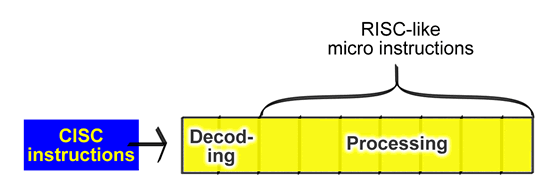
The pipeline is made up of a number stages. Older processors have only a few stages, while the newer ones have many (from 10 to 31). At each stage “something” is done with the instruction, and each stage requires one clock tick from the processor.
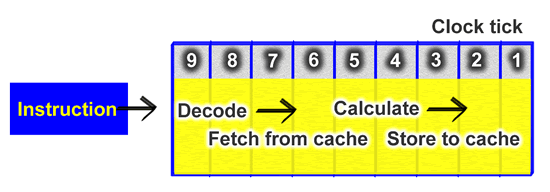
Modern CPU’s have more than one pipeline, and can thus process several instructions at the same time. For example, the Pentium 4 and AthlonXP can decode about 2.5 instructions per clock tick.
The first Pentium 4 has several very long pipelines, allowing the processor to hold up to 126 instructions in total, which are all being processed at the same time, but at different stages of execution (see Fig. 88. It is thus possible to get the CPU to perform more work by letting several pipelines work in parallel:
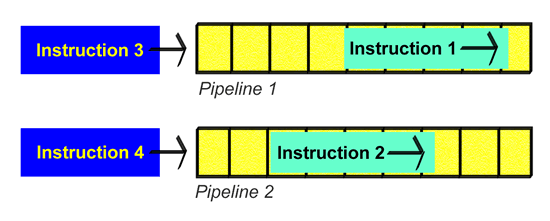
|
CPU |
Instructions
executed |
|
AMD K6-II |
24 |
|
Intel Pentium III |
40 |
|
AMD Athlon |
72 |
|
Intel
Pentium 4 |
126 |
Figure 88. By making use of more, and longer, pipelines, processors can execute more instructions at the same time.
The problems of having more pipelines
One might imagine that the engineers at Intel and AMD could just make even more parallel pipelines in the one CPU. Perhaps performance could be doubled? Unfortunately it is not that easy.
It is not possible to feed a large number of pipelines with data. The memory system is just not powerful enough. Even with the existing pipelines, a fairly large number of clock ticks are wasted. The processor core is simply not utilised efficiently enough, because data cannot be brought to it quickly enough.
Another problem of having several pipelines arises when the processor can decode several instructions in parallel – each in its own pipeline. It is impossible to avoid the wrong instruction occasionally being read in (out of sequence). This is called misprediction and results in a number of wasted clock ticks, since another instruction has to be fetched and run through the “assembly line”.
Intel has tried to tackle this problem using a Branch Prediction Unit, which constantly attempts to guess the correct instruction sequence.
Length of the pipe
The number
of “stations” (stages) in the pipeline varies from processor to
processor. For example, in the Pentium II and III there are 10 stages, while
there are up to
In the Athlon, the ALU pipelines have 10 stages, while the FPU/MMX/SSE pipelines have 15.
The longer the pipeline, the higher the processor’s clock frequency can be. This is because in the longer pipelines, the instructions are cut into more (and hence smaller) sub-instructions which can be executed more quickly.
|
CPU |
Number of |
Maximum clock frequency |
|
Pentium |
5 |
300 MHz |
|
Motorola G4 |
4 |
500 MHz |
|
Motorola G4e |
7 |
1000 MHz |
|
Pentium II and III |
12 |
1400 MHz |
|
Athlon XP |
10/15 |
2500 MHz |
|
Athlon 64 |
12/17 |
>3000 MHz |
|
Pentium 4 |
20 |
>3000 MHz |
|
Pentium
4 „ |
31 |
>5000 MHz |
Figure 89. Higher clock frequencies require long “assembly lines” (pipelines).
Note that the two AMD processors have different pipeline lengths for
integer and floating point instructions. One can also measure a processor’s efficiency
by looking at the IPC number (Instructions Per Clock), and AMD’s Athlon
XP is well ahead of the Pentium
The same is even more true of the Motorola G4 processors used, for example, in Macintosh computers. The G4 only has a 4-stage pipeline, and can therefore, in principle, offer the same performance as a Pentium 4, with only half the clock frequency or less. The only problem is, the clock frequency can’t be raised very much with such a short pipeline. Intel have therefore chosen to future-proof the Pentium 4 by using a very long pipeline.
Execution units
What is it that actually happens in the pipeline? This is where we find the so-called execution units. And we must distinguish between to types of unit:
If the processor has a brain, it is the ALU unit. It is the calculating device that does operations on whole numbers (integers). The computer’s work with ordinary text, for example, is looked after by the ALU.
The ALU is good at working with whole numbers. When it comes to decimal numbers and especially numbers with many decimal places (real numbers as they are called in mathematics), the ALU chokes, and can take a very long time to process the operations. That is why an FPU is used to relieve the load. An FPU is a number cruncher, specially designed for floating point operations.
There are typically several ALU’s and FPU’s in the same processor. The CPU also has other operation units, for example, the LSU (Load/Store Unit).
An example sequence
Look again at Fig. 73. You can see that the processor core is right beside the L1 cache. Imagine that an instruction has to be processed:
This description applies to the working cycle in, for example, the Pentium III and Athlon. As a diagram it might look like this:
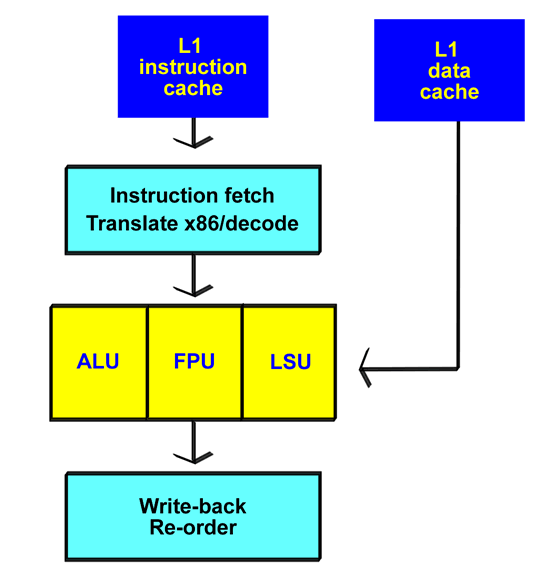
But the way the relationship between the pipeline and the execution units is designed differs greatly from processor to processor. So this entire examination should be taken as a general introduction and nothing more.
Pipelines in the Pentium 4
In the Pentium 4, the instruction cache has been placed between the “Instruction fetch/Translate” unit (in Fig. 90 and the ALU/FPU. Here the instruction cache (Execution Trace Cache) doesn’t store the actual instructions, but rather the “half-digested” micro-ops.
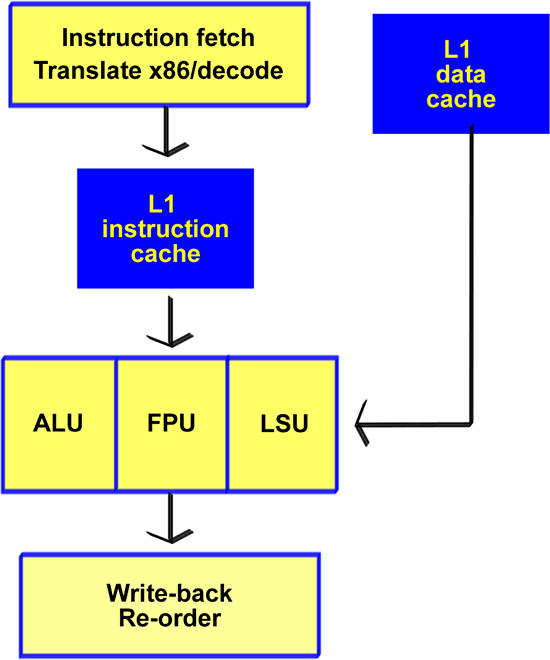
The actual pipeline in the Pentium 4 is longer than in other CPU’s; it has 20 stages. The disadvantage of the long pipeline is that it takes more clock ticks to get an instruction through it. 20 stages require 20 clock ticks, and that reduces the CPU’s efficiency. This was very clear when the Pentium 4 was released; all tests showed that it was much slower than other processors with the same clock frequency.
At the same time, the cost of reading the wrong instruction (misprediction) is much greater – it takes a lot of clock ticks to fill up the long assembly line again.
The Pentium
4’s architecture must therefore be seen from a longer-term perspective. Intel
expects to be able to scale up the design to work at clock frequencies of up to
5-10 GHz. In the “
AMD’s 32 bit Athlon line can barely make it much above a clock frequency of 2 GHz, because of the short pipeline. In comparison, the Pentium 4 is almost ”light years” ahead.